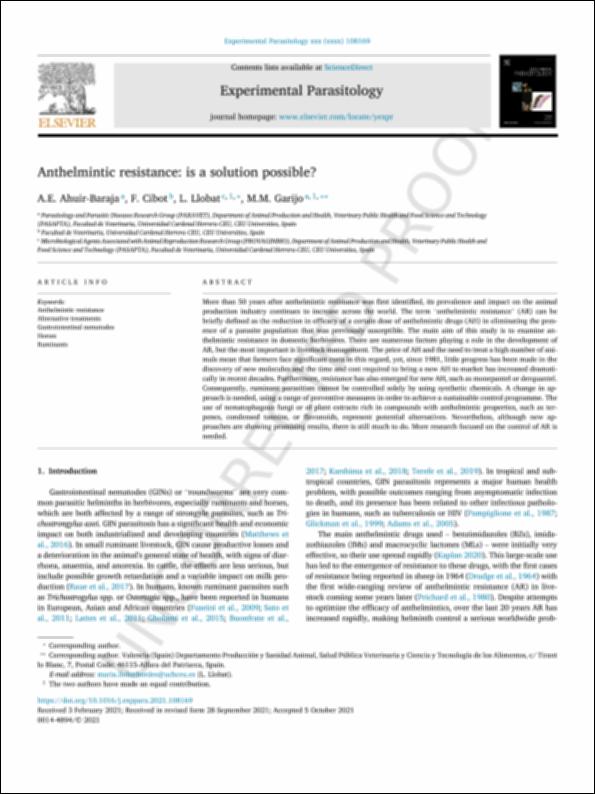Por favor, use este identificador para citar o enlazar este ítem:
http://hdl.handle.net/10637/13457Anthelmintic resistance : is a solution possible?
| Título : | Anthelmintic resistance : is a solution possible? |
| Autor : | Ahuir Baraja, Ana Elena Cibot, F. Llobat Bordes, Lola Garijo Toledo, María Magdalena |
| Materias: | Antihelmínticos en veterinaria.; Anthelmintics.; Drug resistance in microorganisms.; Medicamentos veterinarios.; Bacterias - Resistencia a los medicamentos.; Veterinary drugs. |
| Editorial : | Elsevier |
| Citación : | Ahuir-Baraja, A.E., Cibot, F., Llobat, L. & Garijo, M.M. (2021). Anthelmintic resistance: is a solution possible?. Experimental parasitology, vol. 230, art. 108169 (nov.). DOI: https://doi.org/10.1016/j.exppara.2021.108169 |
| Resumen : | More than 50 years after anthelmintic resistance was first identified, its prevalence and impact on the animal production industry continues to increase across the world. The term “anthelmintic resistance” (AR) can be briefly defined as the reduction in efficacy of a certain dose of anthelmintic drugs (AH) in eliminating the presence of a parasite population that was previously susceptible. The main aim of this study is to examine anthelmintic resistance in domestic herbivores. There are numerous factors playing a role in the development of AR, but the most important is livestock management. The price of AH and the need to treat a high number of animals mean that farmers face significant costs in this regard, yet, since 1981, little progress has been made in the discovery of new molecules and the time and cost required to bring a new AH to market has increased dramatically in recent decades. Furthermore, resistance has also emerged for new AH, such as monepantel or derquantel. Consequently, ruminant parasitism cannot be controlled solely by using synthetic chemicals. A change in approach is needed, using a range of preventive measures in order to achieve a sustainable control programme. The use of nematophagous fungi or of plant extracts rich in compounds with anthelmintic properties, such as terpenes, condensed tannins, or flavonoids, represent potential alternatives. Nevertheless, although new approaches are showing promising results, there is still much to do. More research focused on the control of AR is needed. |
| Descripción : | Este artículo se encuentra disponible en la siguiente URL: https://www.sciencedirect.com/science/article/abs/pii/S0014489421001065?via%3Dihub This is the peer reviewed version of the following article: Ahuir-Baraja, A. E., Cibot, F., Llobat, L. & Garijo, M. M. (2021). Anthelmintic resistance: is a solution possible?. Experimental parasitology, vol. 230 (nov.), art. 108169, which has been published in final form at https://doi.org/10.1016/j.exppara.2021.108169 Este es el post-print del siguiente artículo: Ahuir-Baraja, A. E., Cibot, F., Llobat, L. & Garijo, M. M. (2021). Anthelmintic resistance: is a solution possible?. Experimental parasitology, vol. 230 (nov.), art. 108169, que se ha publicado de forma definitiva en https://doi.org/10.1016/j.exppara.2021.108169 |
| URI : | http://hdl.handle.net/10637/13457 |
| Derechos: | http://creativecommons.org/licenses/by-nc-nd/4.0/deed.es |
| ISSN : | 0014-4894 |
| Fecha de fin de embargo : | 2022-12-01 |
| Fecha de publicación : | 5-nov-2021 |
| Centro : | Universidad Cardenal Herrera-CEU |
| Aparece en las colecciones: | Dpto. Producción y Sanidad Animal, Salud Pública Veterinaria y Ciencia y Tecnología de los Alimentos |
Los ítems de DSpace están protegidos por copyright, con todos los derechos reservados, a menos que se indique lo contrario.


